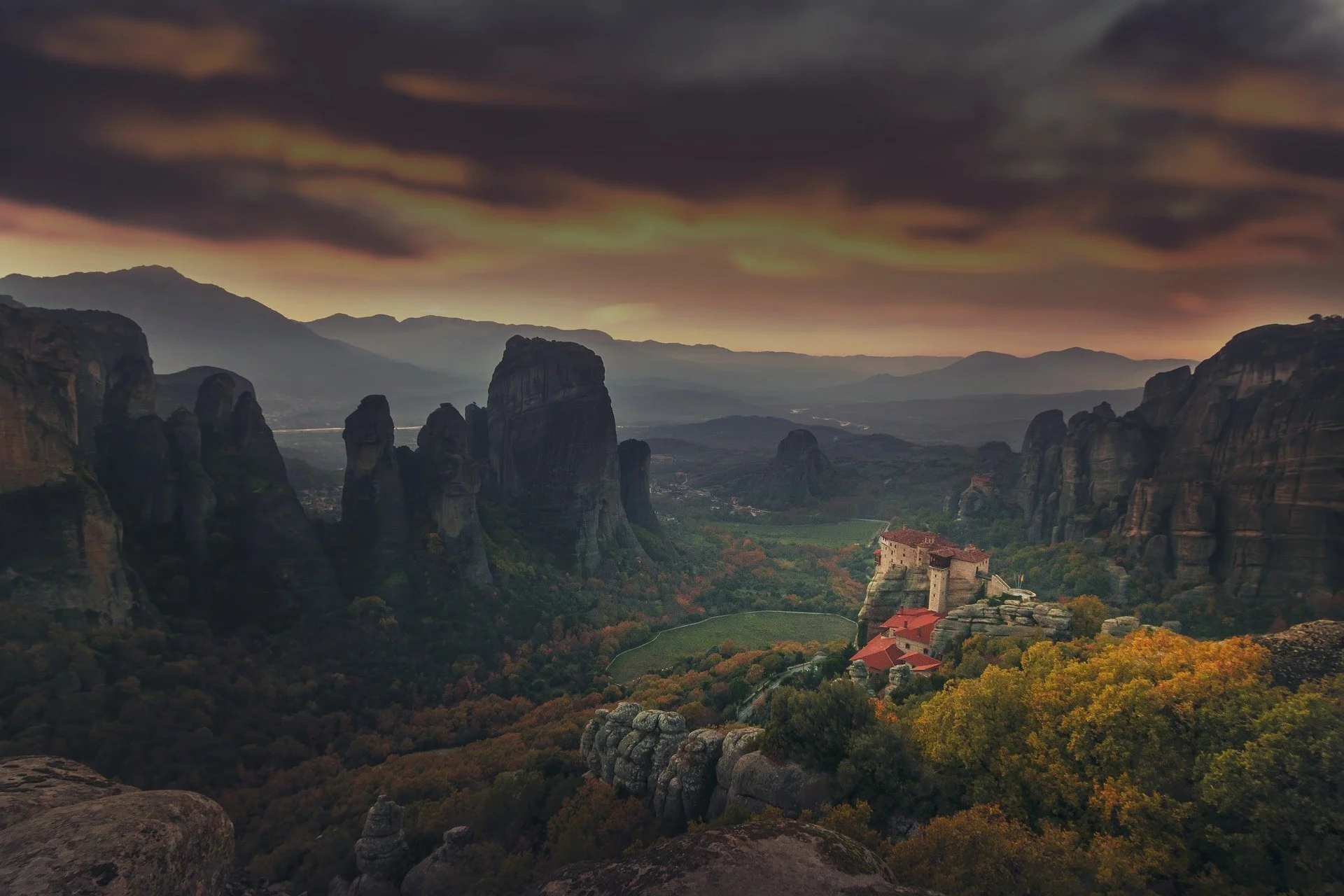NORTHERN GREECE EXPERIENCE: Vikos Gorge and Meteora, 7 Days
This itinerary visits Ioannina, the villages of the Zagori mountains, Vikos-Aoos National Park and the Meteora monasteries.
Northern Greece is often overlooked by tourists in favor of the country’s Mediterranean south and islands. The area known as Epirus, is a predominantly rugged and mountainous region in the far north-western corner of mainland Greece on the border with the Albania region.
The 48 villages of Zagori are home to stone-built mansions topped off with smart slate roofs, built by wealthy merchants in the 18th and 19th centuries. The area is also dotted with monasteries, the most famous known as the Meteora. The Meteora is a rock formation hosting one of the largest and most precipitously built complexes of Eastern Orthodox monasteries.
DAY 1
Ioannina, the capital of the Epirus region spreads out around beautiful Lake Pamvotida. A walk through the city brings you to the imposing castle of Ioannina built in 528 AD. The Ottoman mosque of Veli Pasha and the entire historic center of the town are unique attractions.
If time permits, unwind at a local cafe and indulge into one of the traditional Ioannina desserts.
The exceptionally delicious baklava and the other syrup pastries are but a few of the flavors that captivate visitors.
How to get there:
Daily flights from Athens. (1-hour flight time) Aegean Airlines is the national carrier.
By car —from Thessaloniki on the Egnatia Highway, 3 hrs.
—from Athens on the scenic route over the Rio Antirrio Bridge in 5 hours.
Overnight: Ioannina. <Where to stay>
Monodendri, Zagori Village
DAY 2
Explore the villages of Zagori.
Early morning you travel to the picturesque region of Zagori (aka Epirus), with its traditional stone-built villages with the wild beauty of its landscape.
The tourism is local. You won’t find tour buses or hordes of vacationers–Zagori really is off the beaten path when it comes to travel in Greece.
Map and description of the main villages.
Monodendri – one of the nicest villages completely build in the traditional style with stone houses, stone roofs and even stone pavement. It’s a good place to stay.
The village of Papigo is probably the most visited due to its cobblestone alleys and the traditional stone houses. It’s a “must see” location.
Local delicacies to try are the smoked metsovone cheese, spicy vasiloteri cheese, spanakopita (spinach pie), and Greek lamb souvlaki.
Overnight: Zagori. <Where to stay>
You may want to add an extra day to enjoy the people, food and wine.
Driving time: Ioannina —-> Zagori, 50 minutes
DAY 3.
Discover the spectacular Gorge of Vikos.
Visit Vikos-Aoos National Park, comprising the Vikos Gorge, carved by the Voidomatis river. The park is one of the last European strongholds, and a variety of natural habitats and ecosystems that rank it among the most valuable parks for nature conservation in Europe.
The Vikos Gorge offers some of the best hiking in Greece. There are hikes for all levels of fitness, from one (1) hour hikes to five (5) hour treks.
The gorge of Vikos, with a length of 20 km, is listed in the Guinness Book of Records as the deepest canyon in the world, in proportion to its width. The main part of the gorge stretches between the villages Vikos and Monodendri and has a depth of about 1000 meters.
Best hike: Vikos Gorge Trail: is a 12 km point-to-point moderate trail located near the villages of Vikos and Monodendri.
Another good hike: Ice Age Voidomatis Trail, a 10 km trail moderately trafficked RT near Klidonia/Papingo. <location>
For non-hikers, there are several viewpoints, all easily reached.
Agia Paraskevi Monastery provides one of the best Vikos canyon views. From the village of Monodrendri it is a short walk to the monastery. <trail>
If your interested in a non hiking adventure, river rafting on the Voidamatis River has become a very popular choice.
The Voidomatis river lies amidst a scenery of breathtaking beauty and is ideal for beginners.
Afterward travel toward the village of Kastraki, a picturesque town at the feet of Meteora. A 3-hour drive.
Overnight: Kastraki, (2 nights)
Distance: Zagori —> Kastraki, 3 hrs.
Option - add an extra day if you enjoy hiking
Map of Monasteries
Source: mappingeurope.com
DAY 4.
Full day discovering and hiking The Meteors.
Hiking in a breathtaking scenery between the impressive gigantic monoliths and visiting the magnificent monasteries built on the rocks. In 1989, UNESCO recognized the Meteors in the list of World Heritage Sites.
Recommended: A circular walk starting in Kastraki.
Hiking: 4 hrs., rated—moderate.
The following monasteries are located nearby the road circuiting Meteora. Clockwise you'll find:
St. Nikolaos Anapafsas—is the first Monastery you will encounter on your way to the Meteora.
The monastery is a 1-km walk from Kastraki village.
St. Barbara of Roussanou—the main cathedral, celebrating the memory of Santa Barbara, was founded at the end of the 16th century.
Varlaam—the Holy Monastery of Varlaam is the second biggest monastery. It is opposite the Great Meteoro Monastery.
Great Meteoron—the Holy Monastery of Great Meteoro is the biggest and oldest one of all, dating back to the 14th century. It was called the monastery that was "suspended in the air" (meteoro), because of the formation of the gigantic rock on top of which it was built.
Holy Trinity—the Monastery of Holy Trinity is the most difficult to reach, but once you get to the very top, the panoramic view of the surroundings is simply captivating!
St. Stephen—this is the most accessible monastery. You simply cross a small bridge to reach the entrance. It is ideal for visitors who have difficulty walking and yet they wish to have a real experience of a Meteora monastery.
Be Aware: there is a strict dress code if you want to visit the monasteries.
Men must wear long pants and women long skirts. Sleeveless shirts are not allowed.
Most people who visit Meteora stay overnight either in Kalambaka or in the smaller village of Kastraki.
Kastraki is smaller and closer to the monasteries. Most people prefer staying here.
Overnight: Kastraki
Parga, a place to relax
DAYS 5 and 6
Depart for Parga, nestled in a picturesque bay.
Nested between lush green hills & the clear waters of the Ionian Sea. A nice way to end a holiday.
The resort town is known as “The Riviera of the Epirus Region”. Walk by the waterfront lined by tourist shops, beautiful stylish restaurants and little bars to drink or eat with a view.
Overnight: Parga (2 nights)
Distance: Kastraki —> Parga, 3 hr, 15 min.
DAY 7.
Depart Parga and arrive in Ioannina by afternoon and embark to another Greek destination or return home.
Distance: Parga —> Ioannina, 1 hr: 15 min.
Average cost:
(EXCLUDING AIRFARE)
$$$ USD for two (2) people
Budget: $1,800
Moderate: $2,400
Luxury: $3,200 +
Climate Guide:
May, June, September and early-October you will experience good weather with pleasant average temperatures that fall between 20 degrees Celsius (68°F) and 26 degrees Celsius (80°F).
July and August are the warmest months. It is peak season and most crowded.
The months of mid-October through early-April have a high chance of precipitation and cooler temperatures.
References: mappingeurope.com, wikipedia.orgNo copyright infringement is intended on this website by travelwildnow.com









